HI6025 Accounting Theory and Current Issues: Global Reporting Analysis
VerifiedAdded on 2023/04/20
|16
|4118
|181
Report
AI Summary
This report assesses the global reporting system's importance and its role in investment decisions. It covers the applicability of global reporting standards, the Corporation Act, asset revaluation approaches, impairment of intangible assets, and the materiality of accounting standards in leasing. Public interest theory, capture theory, and the economic interest group theory of regulation are discussed in relation to the amendment of the Corporation Act. The report also examines the reporting of assets at cost value versus fair value and the impact of financial statement classifications on investors. The financial reporting should have qualitative characteristics like relevance, faithful representation and timeliness of report so that the users of the financial report can assess and apply the same for decision-making.
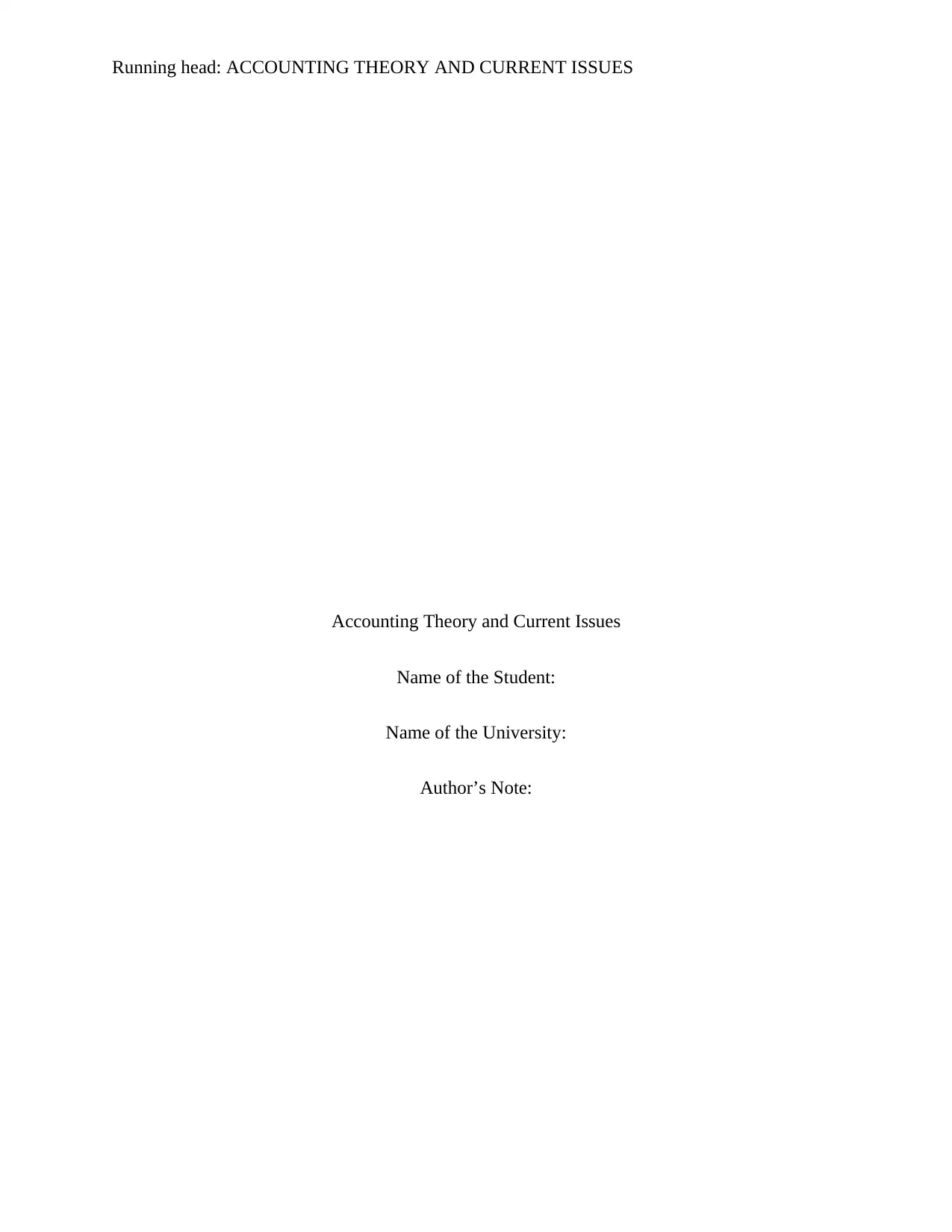
Running head: ACCOUNTING THEORY AND CURRENT ISSUES
Accounting Theory and Current Issues
Name of the Student:
Name of the University:
Author’s Note:
Accounting Theory and Current Issues
Name of the Student:
Name of the University:
Author’s Note:
Paraphrase This Document
Need a fresh take? Get an instant paraphrase of this document with our AI Paraphraser
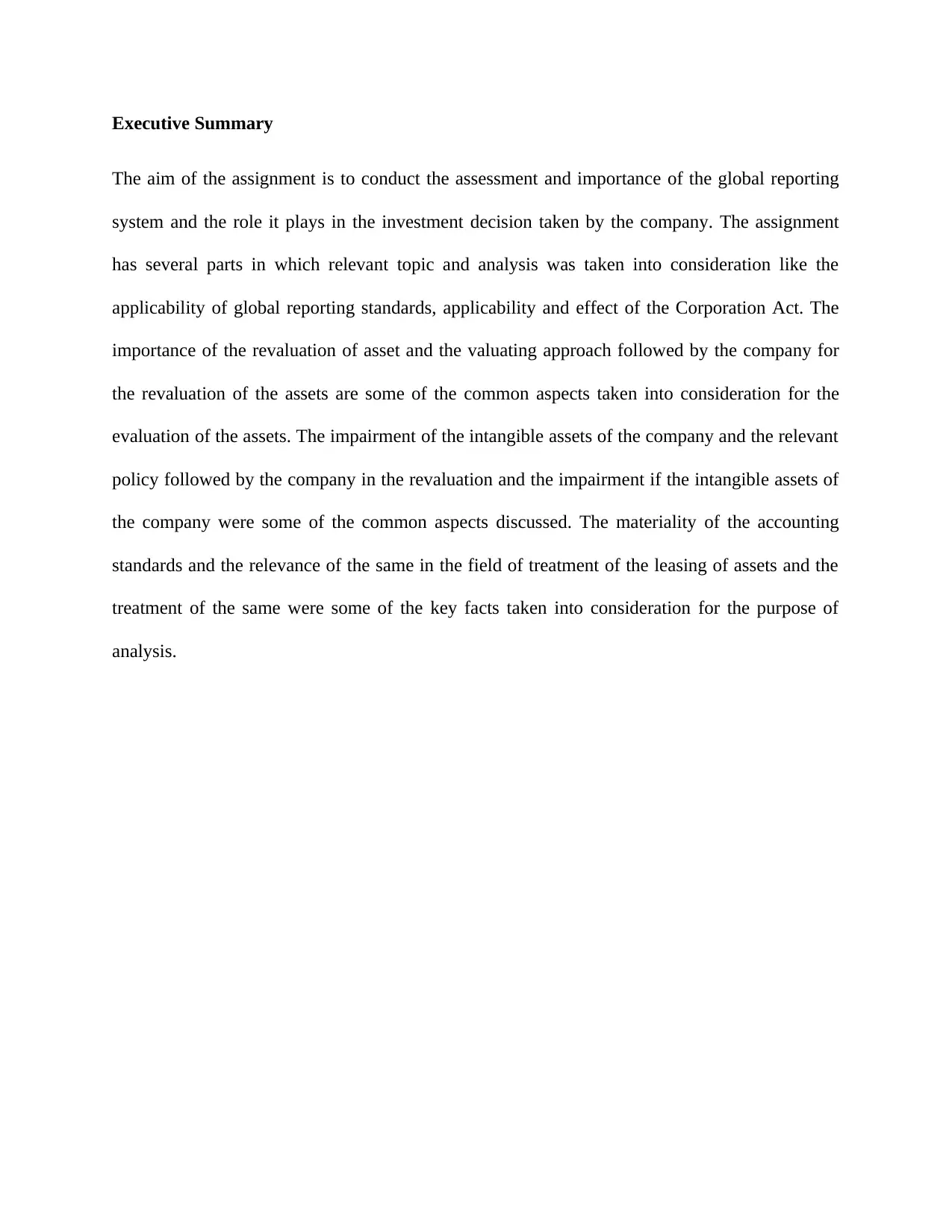
Executive Summary
The aim of the assignment is to conduct the assessment and importance of the global reporting
system and the role it plays in the investment decision taken by the company. The assignment
has several parts in which relevant topic and analysis was taken into consideration like the
applicability of global reporting standards, applicability and effect of the Corporation Act. The
importance of the revaluation of asset and the valuating approach followed by the company for
the revaluation of the assets are some of the common aspects taken into consideration for the
evaluation of the assets. The impairment of the intangible assets of the company and the relevant
policy followed by the company in the revaluation and the impairment if the intangible assets of
the company were some of the common aspects discussed. The materiality of the accounting
standards and the relevance of the same in the field of treatment of the leasing of assets and the
treatment of the same were some of the key facts taken into consideration for the purpose of
analysis.
The aim of the assignment is to conduct the assessment and importance of the global reporting
system and the role it plays in the investment decision taken by the company. The assignment
has several parts in which relevant topic and analysis was taken into consideration like the
applicability of global reporting standards, applicability and effect of the Corporation Act. The
importance of the revaluation of asset and the valuating approach followed by the company for
the revaluation of the assets are some of the common aspects taken into consideration for the
evaluation of the assets. The impairment of the intangible assets of the company and the relevant
policy followed by the company in the revaluation and the impairment if the intangible assets of
the company were some of the common aspects discussed. The materiality of the accounting
standards and the relevance of the same in the field of treatment of the leasing of assets and the
treatment of the same were some of the key facts taken into consideration for the purpose of
analysis.
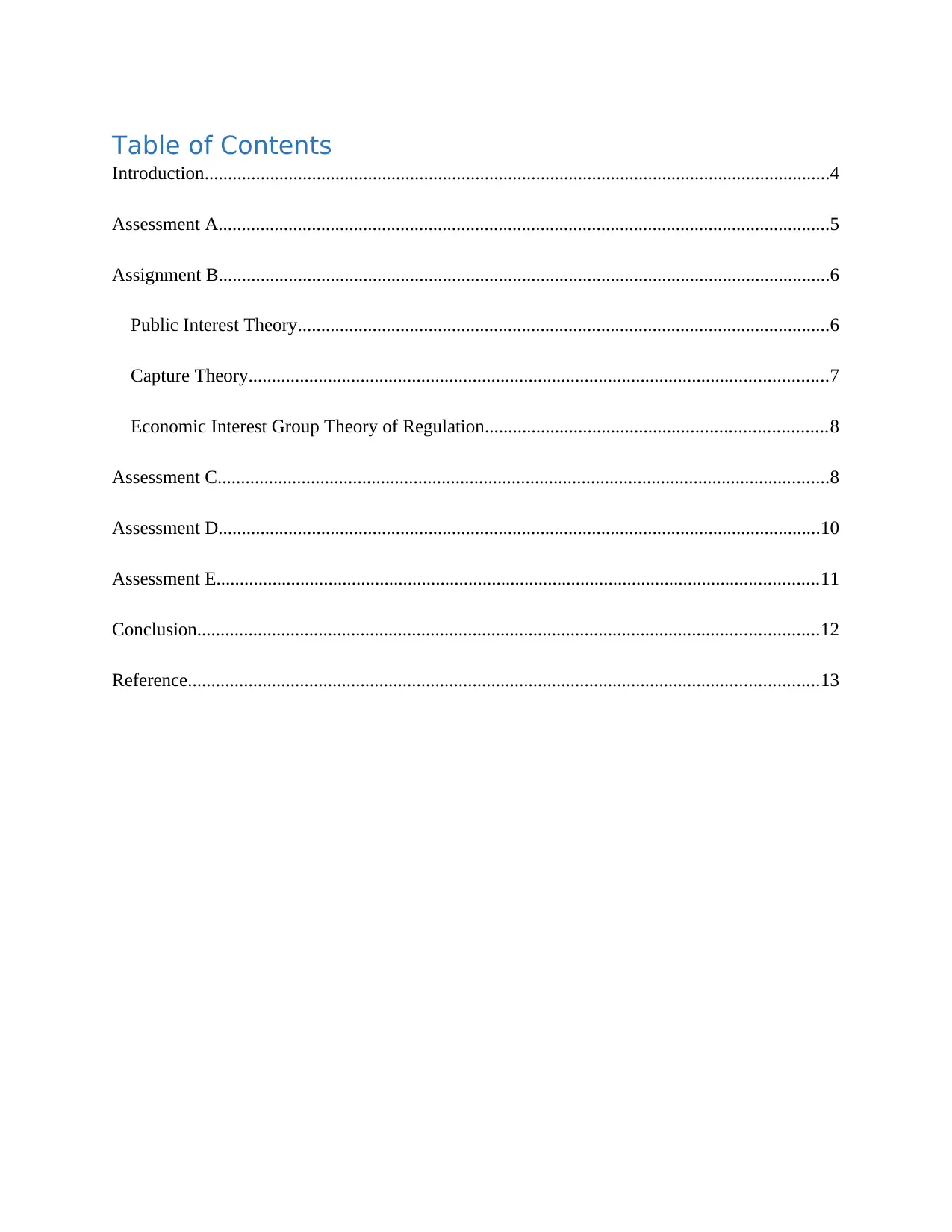
Table of Contents
Introduction......................................................................................................................................4
Assessment A...................................................................................................................................5
Assignment B...................................................................................................................................6
Public Interest Theory..................................................................................................................6
Capture Theory............................................................................................................................7
Economic Interest Group Theory of Regulation.........................................................................8
Assessment C...................................................................................................................................8
Assessment D.................................................................................................................................10
Assessment E.................................................................................................................................11
Conclusion.....................................................................................................................................12
Reference.......................................................................................................................................13
Introduction......................................................................................................................................4
Assessment A...................................................................................................................................5
Assignment B...................................................................................................................................6
Public Interest Theory..................................................................................................................6
Capture Theory............................................................................................................................7
Economic Interest Group Theory of Regulation.........................................................................8
Assessment C...................................................................................................................................8
Assessment D.................................................................................................................................10
Assessment E.................................................................................................................................11
Conclusion.....................................................................................................................................12
Reference.......................................................................................................................................13
⊘ This is a preview!⊘
Do you want full access?
Subscribe today to unlock all pages.

Trusted by 1+ million students worldwide
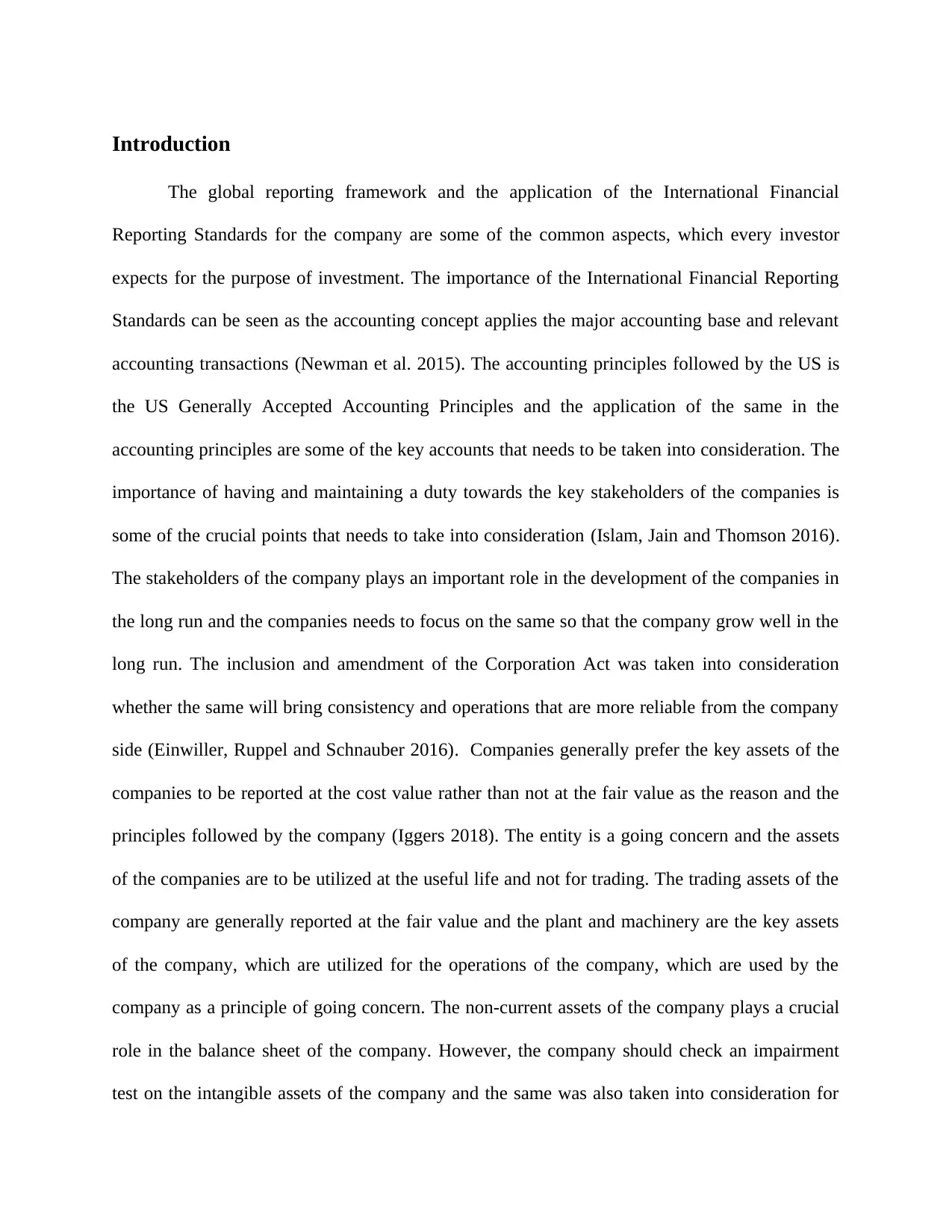
Introduction
The global reporting framework and the application of the International Financial
Reporting Standards for the company are some of the common aspects, which every investor
expects for the purpose of investment. The importance of the International Financial Reporting
Standards can be seen as the accounting concept applies the major accounting base and relevant
accounting transactions (Newman et al. 2015). The accounting principles followed by the US is
the US Generally Accepted Accounting Principles and the application of the same in the
accounting principles are some of the key accounts that needs to be taken into consideration. The
importance of having and maintaining a duty towards the key stakeholders of the companies is
some of the crucial points that needs to take into consideration (Islam, Jain and Thomson 2016).
The stakeholders of the company plays an important role in the development of the companies in
the long run and the companies needs to focus on the same so that the company grow well in the
long run. The inclusion and amendment of the Corporation Act was taken into consideration
whether the same will bring consistency and operations that are more reliable from the company
side (Einwiller, Ruppel and Schnauber 2016). Companies generally prefer the key assets of the
companies to be reported at the cost value rather than not at the fair value as the reason and the
principles followed by the company (Iggers 2018). The entity is a going concern and the assets
of the companies are to be utilized at the useful life and not for trading. The trading assets of the
company are generally reported at the fair value and the plant and machinery are the key assets
of the company, which are utilized for the operations of the company, which are used by the
company as a principle of going concern. The non-current assets of the company plays a crucial
role in the balance sheet of the company. However, the company should check an impairment
test on the intangible assets of the company and the same was also taken into consideration for
The global reporting framework and the application of the International Financial
Reporting Standards for the company are some of the common aspects, which every investor
expects for the purpose of investment. The importance of the International Financial Reporting
Standards can be seen as the accounting concept applies the major accounting base and relevant
accounting transactions (Newman et al. 2015). The accounting principles followed by the US is
the US Generally Accepted Accounting Principles and the application of the same in the
accounting principles are some of the key accounts that needs to be taken into consideration. The
importance of having and maintaining a duty towards the key stakeholders of the companies is
some of the crucial points that needs to take into consideration (Islam, Jain and Thomson 2016).
The stakeholders of the company plays an important role in the development of the companies in
the long run and the companies needs to focus on the same so that the company grow well in the
long run. The inclusion and amendment of the Corporation Act was taken into consideration
whether the same will bring consistency and operations that are more reliable from the company
side (Einwiller, Ruppel and Schnauber 2016). Companies generally prefer the key assets of the
companies to be reported at the cost value rather than not at the fair value as the reason and the
principles followed by the company (Iggers 2018). The entity is a going concern and the assets
of the companies are to be utilized at the useful life and not for trading. The trading assets of the
company are generally reported at the fair value and the plant and machinery are the key assets
of the company, which are utilized for the operations of the company, which are used by the
company as a principle of going concern. The non-current assets of the company plays a crucial
role in the balance sheet of the company. However, the company should check an impairment
test on the intangible assets of the company and the same was also taken into consideration for
Paraphrase This Document
Need a fresh take? Get an instant paraphrase of this document with our AI Paraphraser
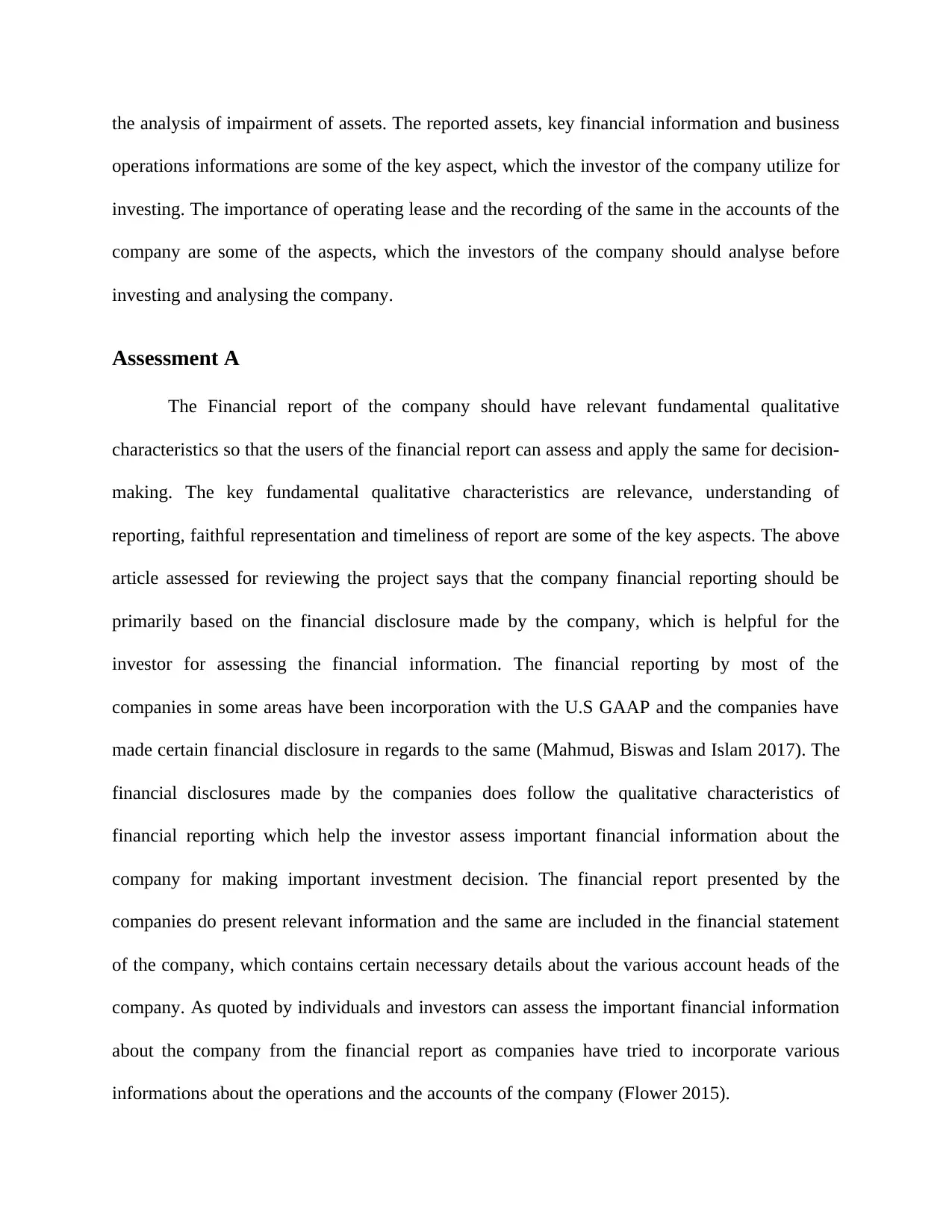
the analysis of impairment of assets. The reported assets, key financial information and business
operations informations are some of the key aspect, which the investor of the company utilize for
investing. The importance of operating lease and the recording of the same in the accounts of the
company are some of the aspects, which the investors of the company should analyse before
investing and analysing the company.
Assessment A
The Financial report of the company should have relevant fundamental qualitative
characteristics so that the users of the financial report can assess and apply the same for decision-
making. The key fundamental qualitative characteristics are relevance, understanding of
reporting, faithful representation and timeliness of report are some of the key aspects. The above
article assessed for reviewing the project says that the company financial reporting should be
primarily based on the financial disclosure made by the company, which is helpful for the
investor for assessing the financial information. The financial reporting by most of the
companies in some areas have been incorporation with the U.S GAAP and the companies have
made certain financial disclosure in regards to the same (Mahmud, Biswas and Islam 2017). The
financial disclosures made by the companies does follow the qualitative characteristics of
financial reporting which help the investor assess important financial information about the
company for making important investment decision. The financial report presented by the
companies do present relevant information and the same are included in the financial statement
of the company, which contains certain necessary details about the various account heads of the
company. As quoted by individuals and investors can assess the important financial information
about the company from the financial report as companies have tried to incorporate various
informations about the operations and the accounts of the company (Flower 2015).
operations informations are some of the key aspect, which the investor of the company utilize for
investing. The importance of operating lease and the recording of the same in the accounts of the
company are some of the aspects, which the investors of the company should analyse before
investing and analysing the company.
Assessment A
The Financial report of the company should have relevant fundamental qualitative
characteristics so that the users of the financial report can assess and apply the same for decision-
making. The key fundamental qualitative characteristics are relevance, understanding of
reporting, faithful representation and timeliness of report are some of the key aspects. The above
article assessed for reviewing the project says that the company financial reporting should be
primarily based on the financial disclosure made by the company, which is helpful for the
investor for assessing the financial information. The financial reporting by most of the
companies in some areas have been incorporation with the U.S GAAP and the companies have
made certain financial disclosure in regards to the same (Mahmud, Biswas and Islam 2017). The
financial disclosures made by the companies does follow the qualitative characteristics of
financial reporting which help the investor assess important financial information about the
company for making important investment decision. The financial report presented by the
companies do present relevant information and the same are included in the financial statement
of the company, which contains certain necessary details about the various account heads of the
company. As quoted by individuals and investors can assess the important financial information
about the company from the financial report as companies have tried to incorporate various
informations about the operations and the accounts of the company (Flower 2015).
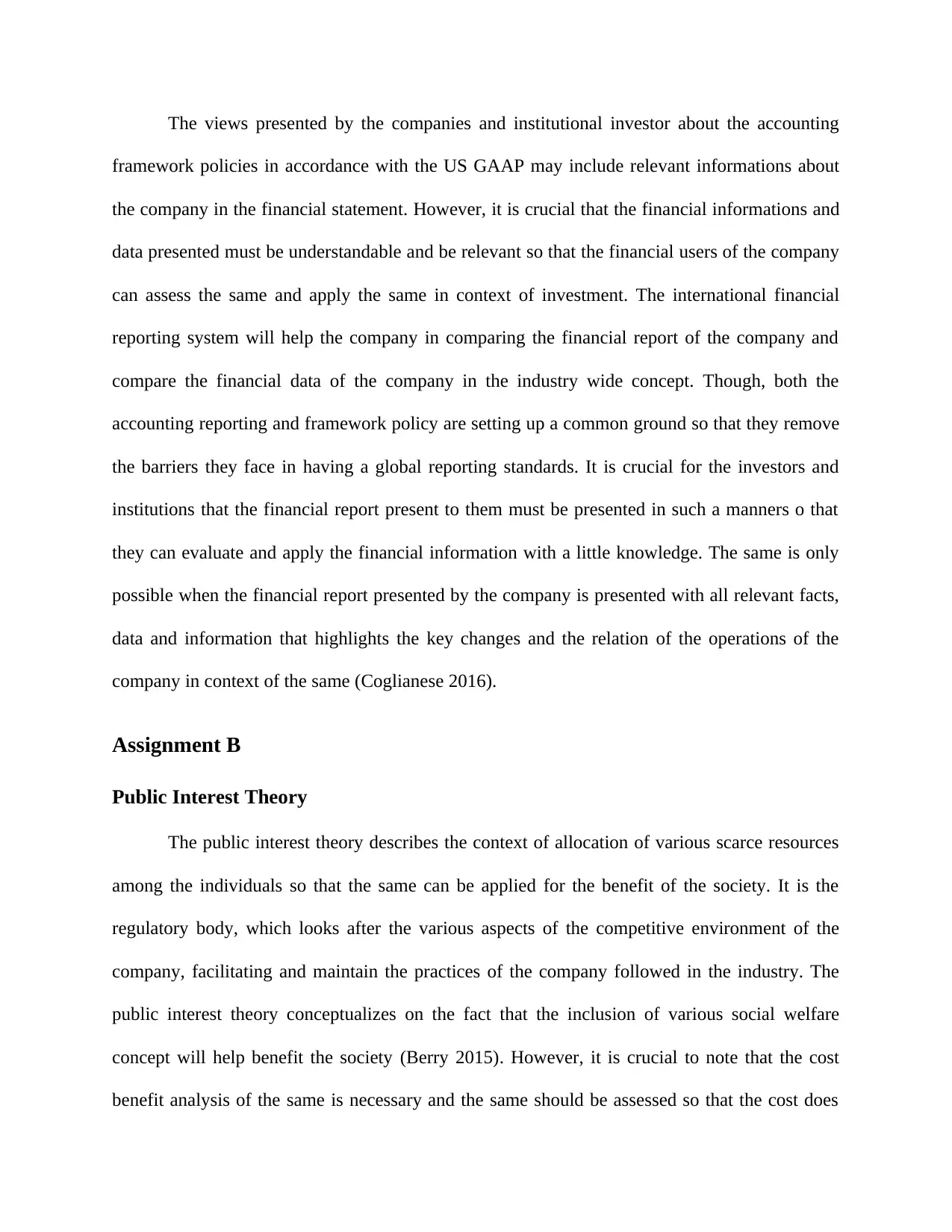
The views presented by the companies and institutional investor about the accounting
framework policies in accordance with the US GAAP may include relevant informations about
the company in the financial statement. However, it is crucial that the financial informations and
data presented must be understandable and be relevant so that the financial users of the company
can assess the same and apply the same in context of investment. The international financial
reporting system will help the company in comparing the financial report of the company and
compare the financial data of the company in the industry wide concept. Though, both the
accounting reporting and framework policy are setting up a common ground so that they remove
the barriers they face in having a global reporting standards. It is crucial for the investors and
institutions that the financial report present to them must be presented in such a manners o that
they can evaluate and apply the financial information with a little knowledge. The same is only
possible when the financial report presented by the company is presented with all relevant facts,
data and information that highlights the key changes and the relation of the operations of the
company in context of the same (Coglianese 2016).
Assignment B
Public Interest Theory
The public interest theory describes the context of allocation of various scarce resources
among the individuals so that the same can be applied for the benefit of the society. It is the
regulatory body, which looks after the various aspects of the competitive environment of the
company, facilitating and maintain the practices of the company followed in the industry. The
public interest theory conceptualizes on the fact that the inclusion of various social welfare
concept will help benefit the society (Berry 2015). However, it is crucial to note that the cost
benefit analysis of the same is necessary and the same should be assessed so that the cost does
framework policies in accordance with the US GAAP may include relevant informations about
the company in the financial statement. However, it is crucial that the financial informations and
data presented must be understandable and be relevant so that the financial users of the company
can assess the same and apply the same in context of investment. The international financial
reporting system will help the company in comparing the financial report of the company and
compare the financial data of the company in the industry wide concept. Though, both the
accounting reporting and framework policy are setting up a common ground so that they remove
the barriers they face in having a global reporting standards. It is crucial for the investors and
institutions that the financial report present to them must be presented in such a manners o that
they can evaluate and apply the financial information with a little knowledge. The same is only
possible when the financial report presented by the company is presented with all relevant facts,
data and information that highlights the key changes and the relation of the operations of the
company in context of the same (Coglianese 2016).
Assignment B
Public Interest Theory
The public interest theory describes the context of allocation of various scarce resources
among the individuals so that the same can be applied for the benefit of the society. It is the
regulatory body, which looks after the various aspects of the competitive environment of the
company, facilitating and maintain the practices of the company followed in the industry. The
public interest theory conceptualizes on the fact that the inclusion of various social welfare
concept will help benefit the society (Berry 2015). However, it is crucial to note that the cost
benefit analysis of the same is necessary and the same should be assessed so that the cost does
⊘ This is a preview!⊘
Do you want full access?
Subscribe today to unlock all pages.

Trusted by 1+ million students worldwide
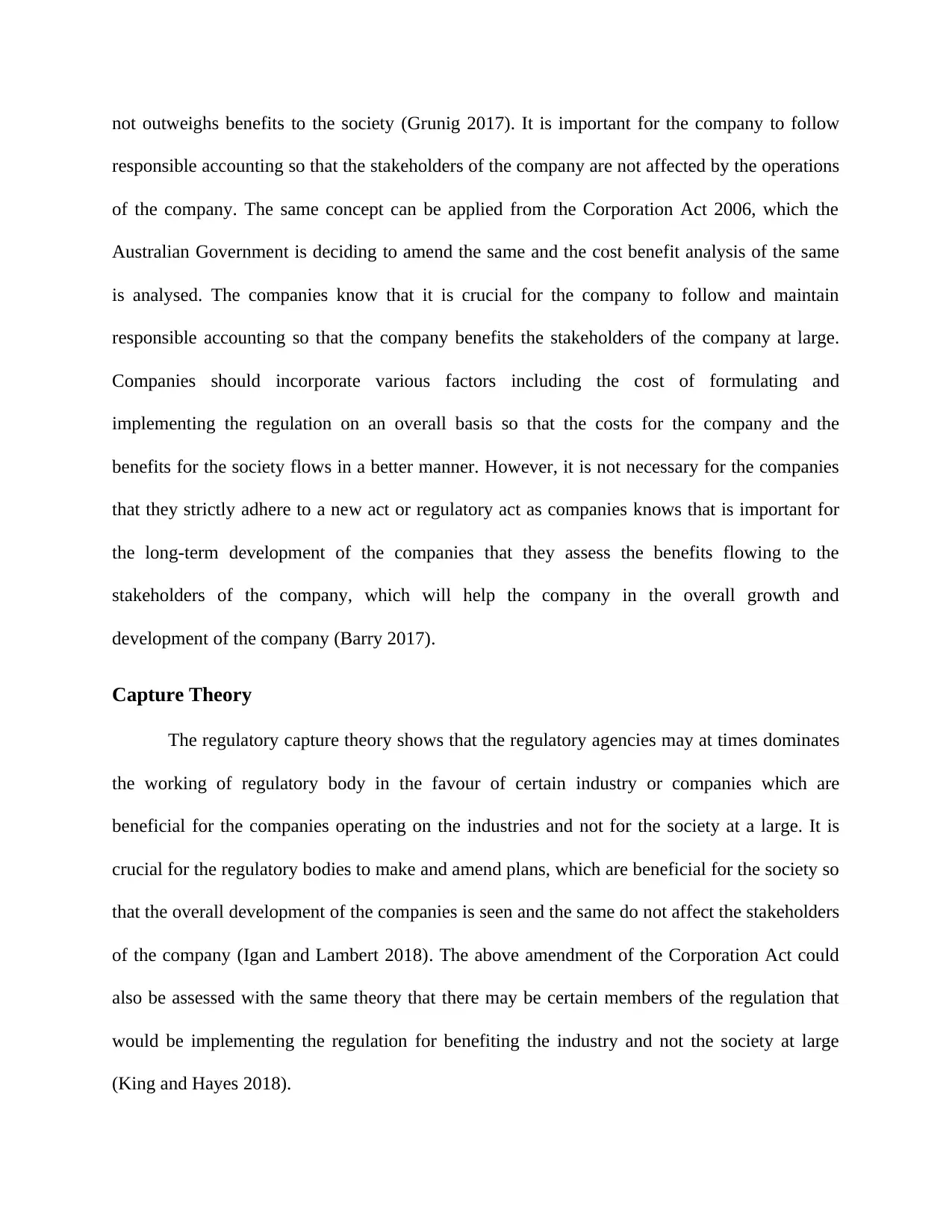
not outweighs benefits to the society (Grunig 2017). It is important for the company to follow
responsible accounting so that the stakeholders of the company are not affected by the operations
of the company. The same concept can be applied from the Corporation Act 2006, which the
Australian Government is deciding to amend the same and the cost benefit analysis of the same
is analysed. The companies know that it is crucial for the company to follow and maintain
responsible accounting so that the company benefits the stakeholders of the company at large.
Companies should incorporate various factors including the cost of formulating and
implementing the regulation on an overall basis so that the costs for the company and the
benefits for the society flows in a better manner. However, it is not necessary for the companies
that they strictly adhere to a new act or regulatory act as companies knows that is important for
the long-term development of the companies that they assess the benefits flowing to the
stakeholders of the company, which will help the company in the overall growth and
development of the company (Barry 2017).
Capture Theory
The regulatory capture theory shows that the regulatory agencies may at times dominates
the working of regulatory body in the favour of certain industry or companies which are
beneficial for the companies operating on the industries and not for the society at a large. It is
crucial for the regulatory bodies to make and amend plans, which are beneficial for the society so
that the overall development of the companies is seen and the same do not affect the stakeholders
of the company (Igan and Lambert 2018). The above amendment of the Corporation Act could
also be assessed with the same theory that there may be certain members of the regulation that
would be implementing the regulation for benefiting the industry and not the society at large
(King and Hayes 2018).
responsible accounting so that the stakeholders of the company are not affected by the operations
of the company. The same concept can be applied from the Corporation Act 2006, which the
Australian Government is deciding to amend the same and the cost benefit analysis of the same
is analysed. The companies know that it is crucial for the company to follow and maintain
responsible accounting so that the company benefits the stakeholders of the company at large.
Companies should incorporate various factors including the cost of formulating and
implementing the regulation on an overall basis so that the costs for the company and the
benefits for the society flows in a better manner. However, it is not necessary for the companies
that they strictly adhere to a new act or regulatory act as companies knows that is important for
the long-term development of the companies that they assess the benefits flowing to the
stakeholders of the company, which will help the company in the overall growth and
development of the company (Barry 2017).
Capture Theory
The regulatory capture theory shows that the regulatory agencies may at times dominates
the working of regulatory body in the favour of certain industry or companies which are
beneficial for the companies operating on the industries and not for the society at a large. It is
crucial for the regulatory bodies to make and amend plans, which are beneficial for the society so
that the overall development of the companies is seen and the same do not affect the stakeholders
of the company (Igan and Lambert 2018). The above amendment of the Corporation Act could
also be assessed with the same theory that there may be certain members of the regulation that
would be implementing the regulation for benefiting the industry and not the society at large
(King and Hayes 2018).
Paraphrase This Document
Need a fresh take? Get an instant paraphrase of this document with our AI Paraphraser
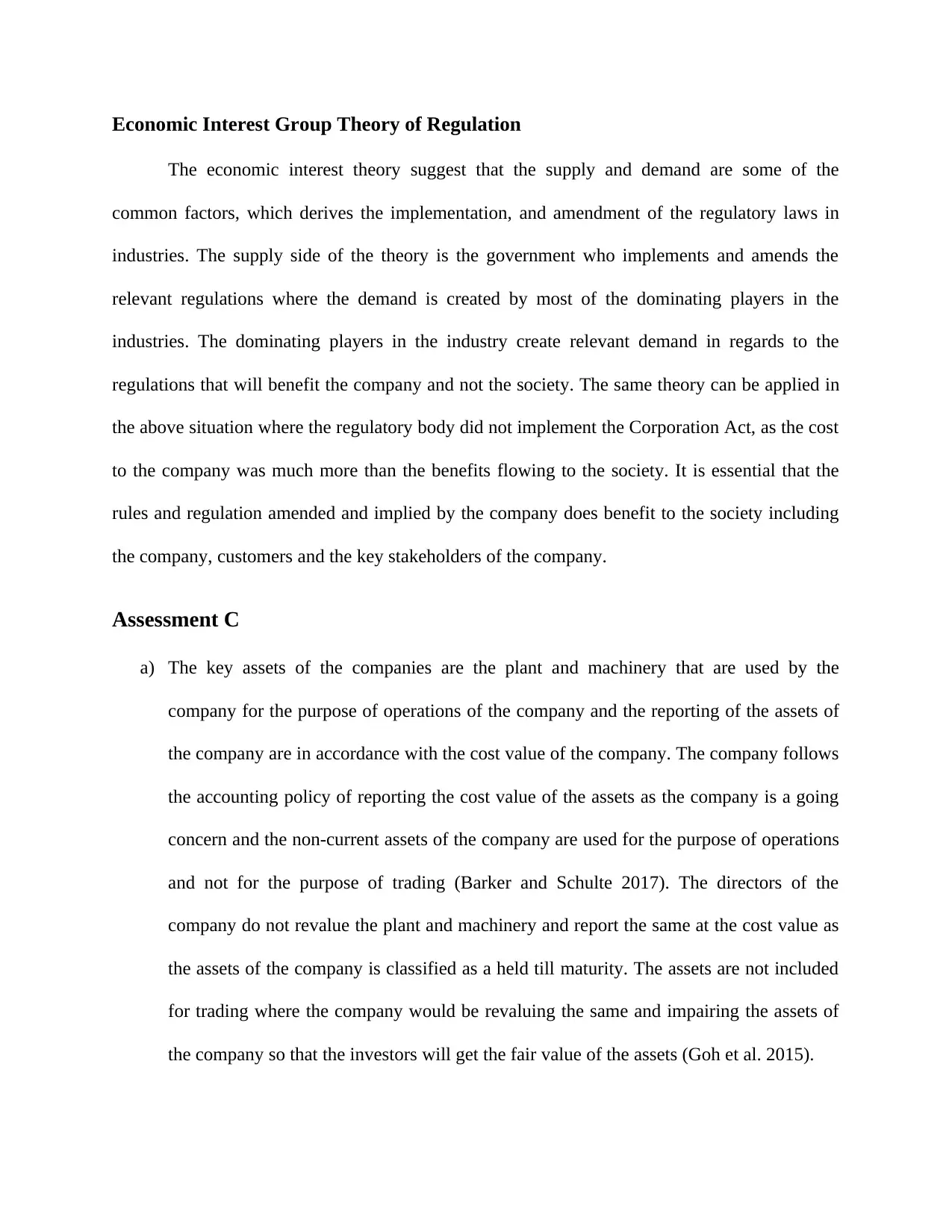
Economic Interest Group Theory of Regulation
The economic interest theory suggest that the supply and demand are some of the
common factors, which derives the implementation, and amendment of the regulatory laws in
industries. The supply side of the theory is the government who implements and amends the
relevant regulations where the demand is created by most of the dominating players in the
industries. The dominating players in the industry create relevant demand in regards to the
regulations that will benefit the company and not the society. The same theory can be applied in
the above situation where the regulatory body did not implement the Corporation Act, as the cost
to the company was much more than the benefits flowing to the society. It is essential that the
rules and regulation amended and implied by the company does benefit to the society including
the company, customers and the key stakeholders of the company.
Assessment C
a) The key assets of the companies are the plant and machinery that are used by the
company for the purpose of operations of the company and the reporting of the assets of
the company are in accordance with the cost value of the company. The company follows
the accounting policy of reporting the cost value of the assets as the company is a going
concern and the non-current assets of the company are used for the purpose of operations
and not for the purpose of trading (Barker and Schulte 2017). The directors of the
company do not revalue the plant and machinery and report the same at the cost value as
the assets of the company is classified as a held till maturity. The assets are not included
for trading where the company would be revaluing the same and impairing the assets of
the company so that the investors will get the fair value of the assets (Goh et al. 2015).
The economic interest theory suggest that the supply and demand are some of the
common factors, which derives the implementation, and amendment of the regulatory laws in
industries. The supply side of the theory is the government who implements and amends the
relevant regulations where the demand is created by most of the dominating players in the
industries. The dominating players in the industry create relevant demand in regards to the
regulations that will benefit the company and not the society. The same theory can be applied in
the above situation where the regulatory body did not implement the Corporation Act, as the cost
to the company was much more than the benefits flowing to the society. It is essential that the
rules and regulation amended and implied by the company does benefit to the society including
the company, customers and the key stakeholders of the company.
Assessment C
a) The key assets of the companies are the plant and machinery that are used by the
company for the purpose of operations of the company and the reporting of the assets of
the company are in accordance with the cost value of the company. The company follows
the accounting policy of reporting the cost value of the assets as the company is a going
concern and the non-current assets of the company are used for the purpose of operations
and not for the purpose of trading (Barker and Schulte 2017). The directors of the
company do not revalue the plant and machinery and report the same at the cost value as
the assets of the company is classified as a held till maturity. The assets are not included
for trading where the company would be revaluing the same and impairing the assets of
the company so that the investors will get the fair value of the assets (Goh et al. 2015).
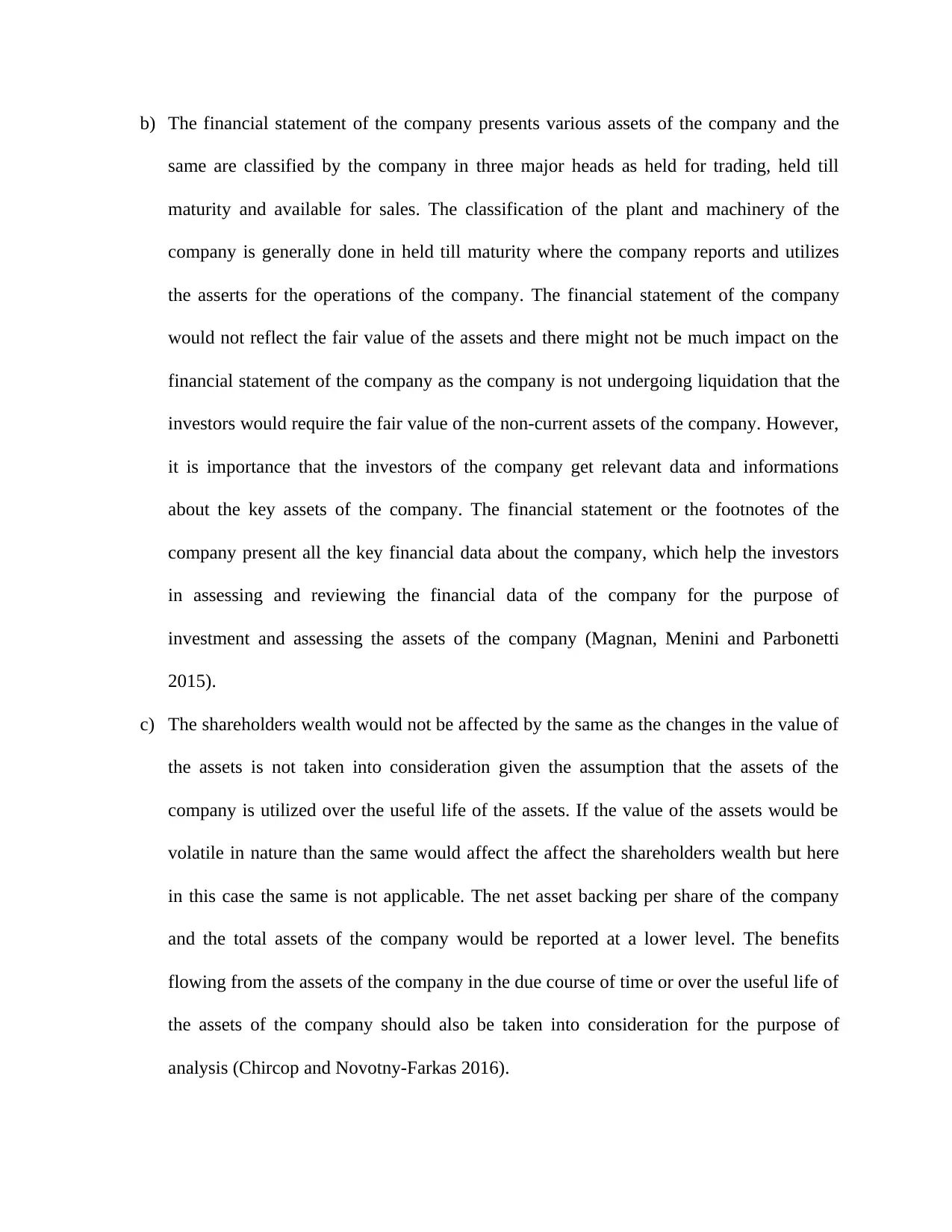
b) The financial statement of the company presents various assets of the company and the
same are classified by the company in three major heads as held for trading, held till
maturity and available for sales. The classification of the plant and machinery of the
company is generally done in held till maturity where the company reports and utilizes
the asserts for the operations of the company. The financial statement of the company
would not reflect the fair value of the assets and there might not be much impact on the
financial statement of the company as the company is not undergoing liquidation that the
investors would require the fair value of the non-current assets of the company. However,
it is importance that the investors of the company get relevant data and informations
about the key assets of the company. The financial statement or the footnotes of the
company present all the key financial data about the company, which help the investors
in assessing and reviewing the financial data of the company for the purpose of
investment and assessing the assets of the company (Magnan, Menini and Parbonetti
2015).
c) The shareholders wealth would not be affected by the same as the changes in the value of
the assets is not taken into consideration given the assumption that the assets of the
company is utilized over the useful life of the assets. If the value of the assets would be
volatile in nature than the same would affect the affect the shareholders wealth but here
in this case the same is not applicable. The net asset backing per share of the company
and the total assets of the company would be reported at a lower level. The benefits
flowing from the assets of the company in the due course of time or over the useful life of
the assets of the company should also be taken into consideration for the purpose of
analysis (Chircop and Novotny-Farkas 2016).
same are classified by the company in three major heads as held for trading, held till
maturity and available for sales. The classification of the plant and machinery of the
company is generally done in held till maturity where the company reports and utilizes
the asserts for the operations of the company. The financial statement of the company
would not reflect the fair value of the assets and there might not be much impact on the
financial statement of the company as the company is not undergoing liquidation that the
investors would require the fair value of the non-current assets of the company. However,
it is importance that the investors of the company get relevant data and informations
about the key assets of the company. The financial statement or the footnotes of the
company present all the key financial data about the company, which help the investors
in assessing and reviewing the financial data of the company for the purpose of
investment and assessing the assets of the company (Magnan, Menini and Parbonetti
2015).
c) The shareholders wealth would not be affected by the same as the changes in the value of
the assets is not taken into consideration given the assumption that the assets of the
company is utilized over the useful life of the assets. If the value of the assets would be
volatile in nature than the same would affect the affect the shareholders wealth but here
in this case the same is not applicable. The net asset backing per share of the company
and the total assets of the company would be reported at a lower level. The benefits
flowing from the assets of the company in the due course of time or over the useful life of
the assets of the company should also be taken into consideration for the purpose of
analysis (Chircop and Novotny-Farkas 2016).
⊘ This is a preview!⊘
Do you want full access?
Subscribe today to unlock all pages.

Trusted by 1+ million students worldwide
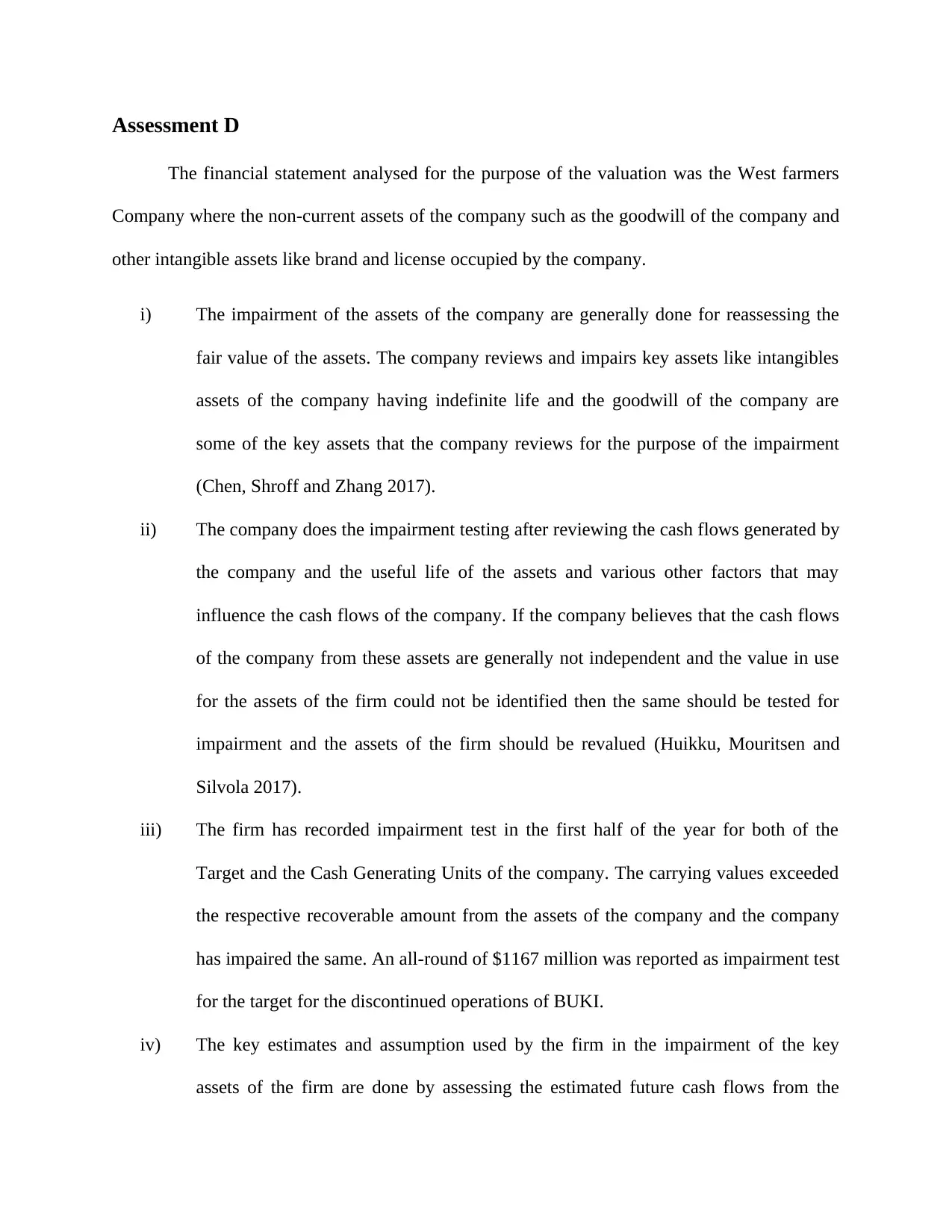
Assessment D
The financial statement analysed for the purpose of the valuation was the West farmers
Company where the non-current assets of the company such as the goodwill of the company and
other intangible assets like brand and license occupied by the company.
i) The impairment of the assets of the company are generally done for reassessing the
fair value of the assets. The company reviews and impairs key assets like intangibles
assets of the company having indefinite life and the goodwill of the company are
some of the key assets that the company reviews for the purpose of the impairment
(Chen, Shroff and Zhang 2017).
ii) The company does the impairment testing after reviewing the cash flows generated by
the company and the useful life of the assets and various other factors that may
influence the cash flows of the company. If the company believes that the cash flows
of the company from these assets are generally not independent and the value in use
for the assets of the firm could not be identified then the same should be tested for
impairment and the assets of the firm should be revalued (Huikku, Mouritsen and
Silvola 2017).
iii) The firm has recorded impairment test in the first half of the year for both of the
Target and the Cash Generating Units of the company. The carrying values exceeded
the respective recoverable amount from the assets of the company and the company
has impaired the same. An all-round of $1167 million was reported as impairment test
for the target for the discontinued operations of BUKI.
iv) The key estimates and assumption used by the firm in the impairment of the key
assets of the firm are done by assessing the estimated future cash flows from the
The financial statement analysed for the purpose of the valuation was the West farmers
Company where the non-current assets of the company such as the goodwill of the company and
other intangible assets like brand and license occupied by the company.
i) The impairment of the assets of the company are generally done for reassessing the
fair value of the assets. The company reviews and impairs key assets like intangibles
assets of the company having indefinite life and the goodwill of the company are
some of the key assets that the company reviews for the purpose of the impairment
(Chen, Shroff and Zhang 2017).
ii) The company does the impairment testing after reviewing the cash flows generated by
the company and the useful life of the assets and various other factors that may
influence the cash flows of the company. If the company believes that the cash flows
of the company from these assets are generally not independent and the value in use
for the assets of the firm could not be identified then the same should be tested for
impairment and the assets of the firm should be revalued (Huikku, Mouritsen and
Silvola 2017).
iii) The firm has recorded impairment test in the first half of the year for both of the
Target and the Cash Generating Units of the company. The carrying values exceeded
the respective recoverable amount from the assets of the company and the company
has impaired the same. An all-round of $1167 million was reported as impairment test
for the target for the discontinued operations of BUKI.
iv) The key estimates and assumption used by the firm in the impairment of the key
assets of the firm are done by assessing the estimated future cash flows from the
Paraphrase This Document
Need a fresh take? Get an instant paraphrase of this document with our AI Paraphraser
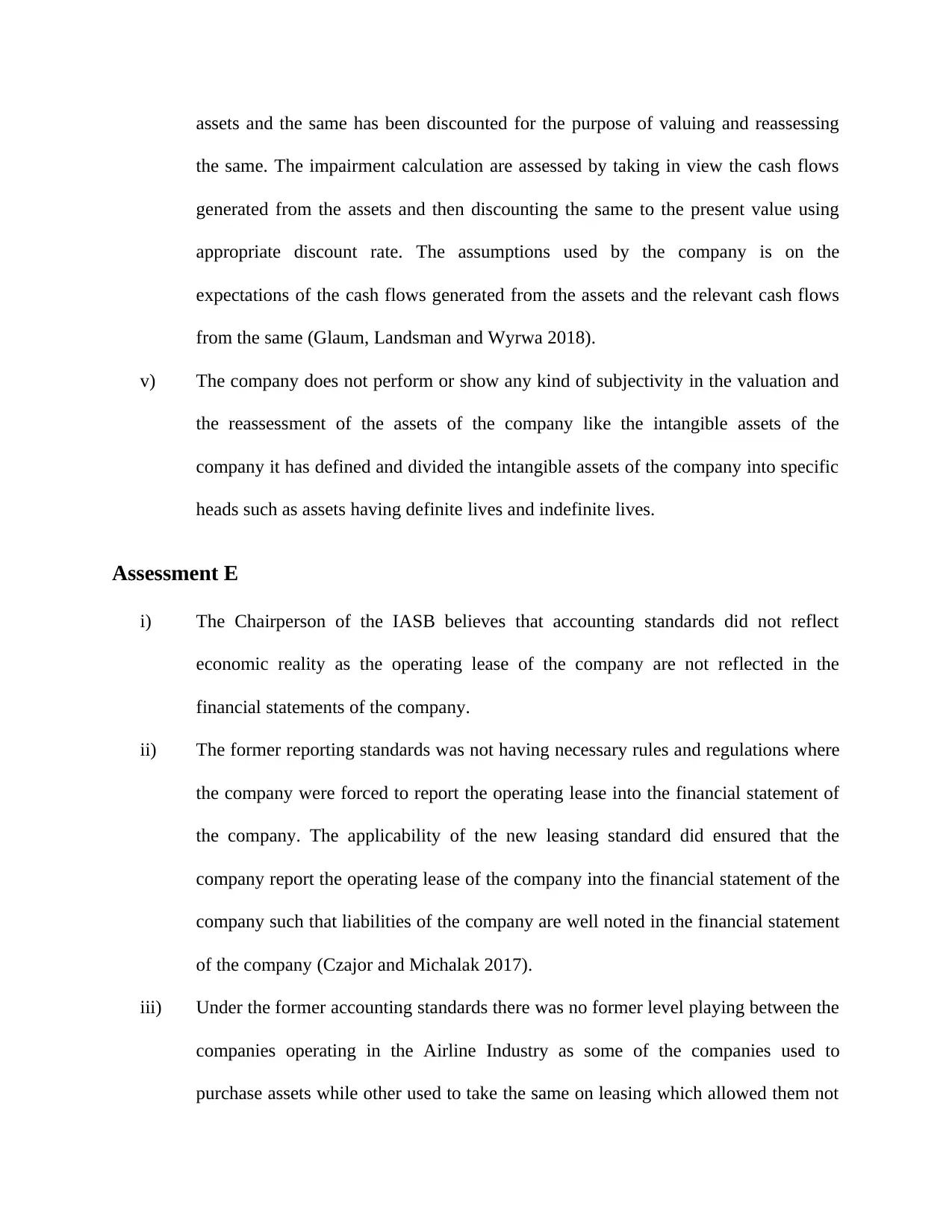
assets and the same has been discounted for the purpose of valuing and reassessing
the same. The impairment calculation are assessed by taking in view the cash flows
generated from the assets and then discounting the same to the present value using
appropriate discount rate. The assumptions used by the company is on the
expectations of the cash flows generated from the assets and the relevant cash flows
from the same (Glaum, Landsman and Wyrwa 2018).
v) The company does not perform or show any kind of subjectivity in the valuation and
the reassessment of the assets of the company like the intangible assets of the
company it has defined and divided the intangible assets of the company into specific
heads such as assets having definite lives and indefinite lives.
Assessment E
i) The Chairperson of the IASB believes that accounting standards did not reflect
economic reality as the operating lease of the company are not reflected in the
financial statements of the company.
ii) The former reporting standards was not having necessary rules and regulations where
the company were forced to report the operating lease into the financial statement of
the company. The applicability of the new leasing standard did ensured that the
company report the operating lease of the company into the financial statement of the
company such that liabilities of the company are well noted in the financial statement
of the company (Czajor and Michalak 2017).
iii) Under the former accounting standards there was no former level playing between the
companies operating in the Airline Industry as some of the companies used to
purchase assets while other used to take the same on leasing which allowed them not
the same. The impairment calculation are assessed by taking in view the cash flows
generated from the assets and then discounting the same to the present value using
appropriate discount rate. The assumptions used by the company is on the
expectations of the cash flows generated from the assets and the relevant cash flows
from the same (Glaum, Landsman and Wyrwa 2018).
v) The company does not perform or show any kind of subjectivity in the valuation and
the reassessment of the assets of the company like the intangible assets of the
company it has defined and divided the intangible assets of the company into specific
heads such as assets having definite lives and indefinite lives.
Assessment E
i) The Chairperson of the IASB believes that accounting standards did not reflect
economic reality as the operating lease of the company are not reflected in the
financial statements of the company.
ii) The former reporting standards was not having necessary rules and regulations where
the company were forced to report the operating lease into the financial statement of
the company. The applicability of the new leasing standard did ensured that the
company report the operating lease of the company into the financial statement of the
company such that liabilities of the company are well noted in the financial statement
of the company (Czajor and Michalak 2017).
iii) Under the former accounting standards there was no former level playing between the
companies operating in the Airline Industry as some of the companies used to
purchase assets while other used to take the same on leasing which allowed them not
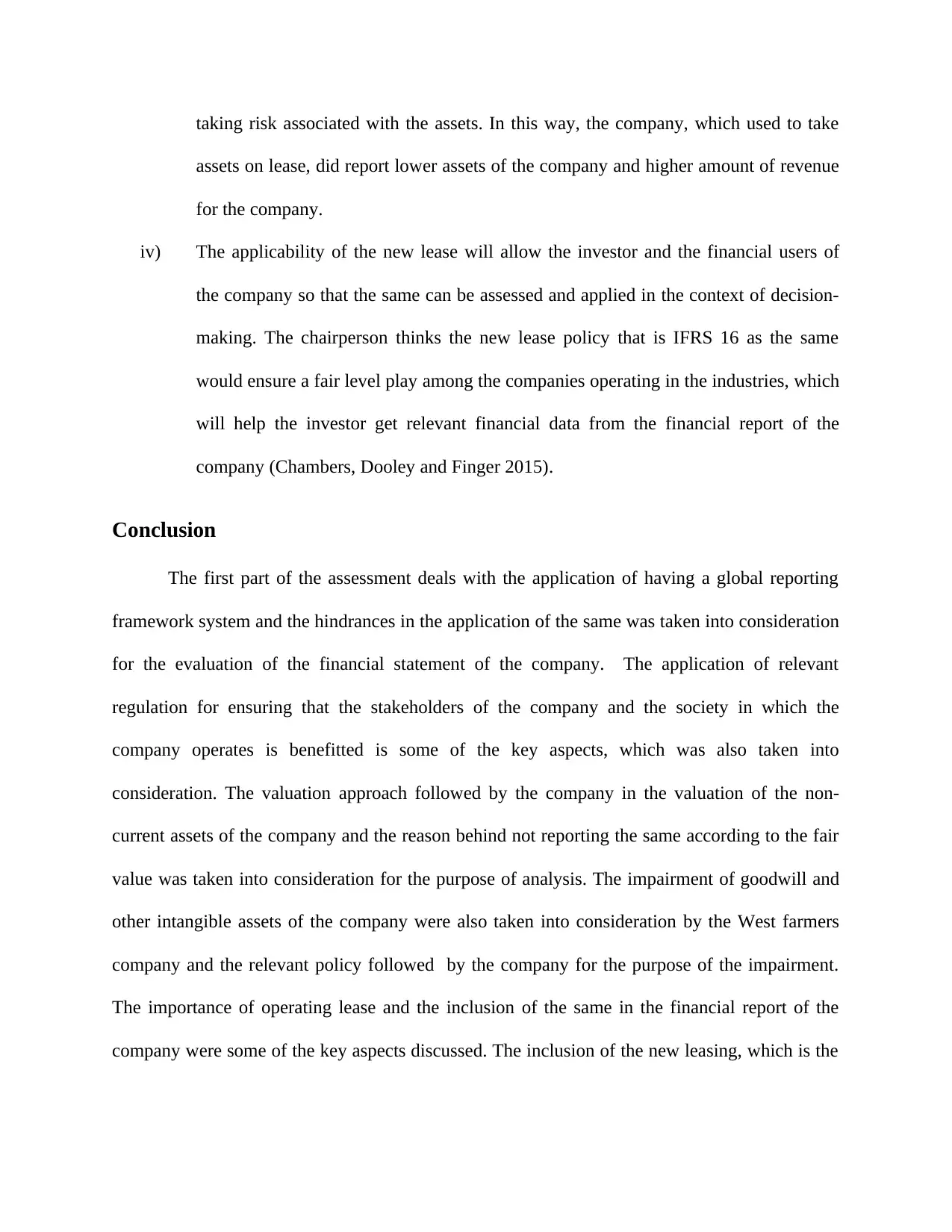
taking risk associated with the assets. In this way, the company, which used to take
assets on lease, did report lower assets of the company and higher amount of revenue
for the company.
iv) The applicability of the new lease will allow the investor and the financial users of
the company so that the same can be assessed and applied in the context of decision-
making. The chairperson thinks the new lease policy that is IFRS 16 as the same
would ensure a fair level play among the companies operating in the industries, which
will help the investor get relevant financial data from the financial report of the
company (Chambers, Dooley and Finger 2015).
Conclusion
The first part of the assessment deals with the application of having a global reporting
framework system and the hindrances in the application of the same was taken into consideration
for the evaluation of the financial statement of the company. The application of relevant
regulation for ensuring that the stakeholders of the company and the society in which the
company operates is benefitted is some of the key aspects, which was also taken into
consideration. The valuation approach followed by the company in the valuation of the non-
current assets of the company and the reason behind not reporting the same according to the fair
value was taken into consideration for the purpose of analysis. The impairment of goodwill and
other intangible assets of the company were also taken into consideration by the West farmers
company and the relevant policy followed by the company for the purpose of the impairment.
The importance of operating lease and the inclusion of the same in the financial report of the
company were some of the key aspects discussed. The inclusion of the new leasing, which is the
assets on lease, did report lower assets of the company and higher amount of revenue
for the company.
iv) The applicability of the new lease will allow the investor and the financial users of
the company so that the same can be assessed and applied in the context of decision-
making. The chairperson thinks the new lease policy that is IFRS 16 as the same
would ensure a fair level play among the companies operating in the industries, which
will help the investor get relevant financial data from the financial report of the
company (Chambers, Dooley and Finger 2015).
Conclusion
The first part of the assessment deals with the application of having a global reporting
framework system and the hindrances in the application of the same was taken into consideration
for the evaluation of the financial statement of the company. The application of relevant
regulation for ensuring that the stakeholders of the company and the society in which the
company operates is benefitted is some of the key aspects, which was also taken into
consideration. The valuation approach followed by the company in the valuation of the non-
current assets of the company and the reason behind not reporting the same according to the fair
value was taken into consideration for the purpose of analysis. The impairment of goodwill and
other intangible assets of the company were also taken into consideration by the West farmers
company and the relevant policy followed by the company for the purpose of the impairment.
The importance of operating lease and the inclusion of the same in the financial report of the
company were some of the key aspects discussed. The inclusion of the new leasing, which is the
⊘ This is a preview!⊘
Do you want full access?
Subscribe today to unlock all pages.

Trusted by 1+ million students worldwide
1 out of 16
Related Documents
Your All-in-One AI-Powered Toolkit for Academic Success.
+13062052269
info@desklib.com
Available 24*7 on WhatsApp / Email
![[object Object]](/_next/static/media/star-bottom.7253800d.svg)
Unlock your academic potential
Copyright © 2020–2025 A2Z Services. All Rights Reserved. Developed and managed by ZUCOL.





